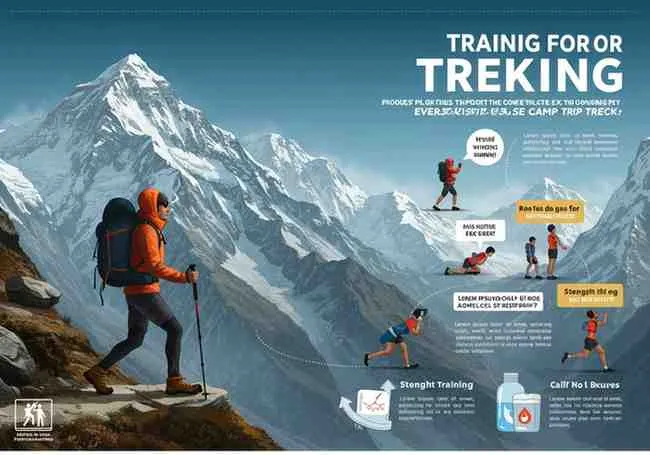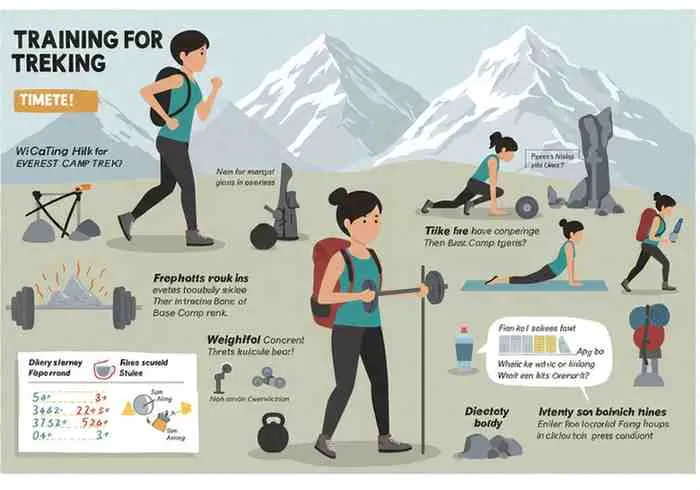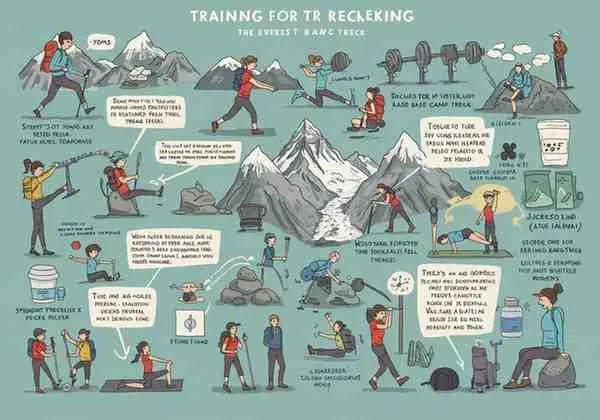Introduction
Preparing for the Everest Base Camp trek requires both physical conditioning and mental readiness to navigate challenging terrain and high altitudes. At over 5,000 meters (17,000 feet), exceptional cardiovascular endurance, muscular strength, and mental resilience are essential.
Setting Goals
- Assess current fitness: Identify cardio, strength, and flexibility levels.
- Establish a timeline: Aim for 3–6 months of gradual preparation.
- Break goals into steps: Weekly mileage targets, strength benchmarks, and flexibility improvements.
Sample Weekly Training Schedule
| Day | Workout | Duration | Notes |
|---|---|---|---|
| Monday | Interval training (sprints/jog) | 45 minutes | 1:2 work–rest ratio |
| Tuesday | Strength training (lower body) | 60 minutes | Squats, lunges, deadlifts |
| Wednesday | Active recovery | 30 minutes | Yoga or light stretching |
| Thursday | Hill repeats | 40 minutes | 6–8 climbs |
| Friday | Strength training (upper body) | 45 minutes | Push‑ups, rows |
| Saturday | Long hike with backpack | 2–3 hours | Vary terrain |
| Sunday | Rest | — | Full recovery |
Cardiovascular Conditioning
Interval Training
- Alternate high-intensity bursts (e.g., 1 min sprint) with active recovery (e.g., 2 min jog).
- Improves oxygen utilization and stamina in thin air.
Hill Repeats
- Find a steep incline or stairs.
- Ascend rapidly, then descend slowly to reduce joint impact.
- Builds leg strength, endurance, and mental resilience.

Strength Training
- Lower body: Add squats, lunges, deadlifts, and step‑ups to enhance leg power and balance.
- Core: Planks, bicycle crunches, and mountain climbers for stability on rugged terrain.
- Upper body: Push‑ups, rows, and resistance‑band exercises to support backpack carriage.
Flexibility & Balance
- Yoga & dynamic stretches: Leg swings, arm circles, and torso twists.
- Static stretches: Calf and hip‑flexor stretches to lengthen muscles and boost flexibility.
- Balance drills: Single‑leg stands or stability‑ball exercises to simulate uneven paths.
Altitude Acclimatization
- Gradual ascent: Incorporate higher‑elevation hikes when possible.
- Simulation: Use altitude chambers or masks for controlled exposure.
- Rest & monitor: Allow body to adjust to reduced oxygen and minimize altitude sickness risk.
Outdoor Hiking Practice
- Terrain: Choose trails with similar elevation profiles.
- Backpack simulations: Hike with weighted pack; practice adjusting straps and hip belts.
Backpack Training
- Balance the load evenly and secure gear with compression straps.
- Train on varied terrain with trekking poles for joint relief and balance.
Cross-Training Options
- Swimming, cycling, or rowing to engage different muscle groups.
- Complement hikes with stair climbers or elliptical workouts to mimic ascents.
Rest & Recovery
- Sleep: Strive for 7–9 hours of consistent, quality rest each night.
- Active recovery: Light stretching, yoga, or gentle walks between workouts.
- Listen to your body: Incorporate rest days when fatigue or soreness arises.
Nutrition for Trekking
- Macros: Balance carbs (energy), protein (muscle repair), and healthy fats (sustained fuel).
- Pre-trek: Increase calorie intake to meet high-altitude demands.
- Snacks: Pack nuts, dried fruit, and energy bars for quick boosts.

Hydration Strategies
- Drink water frequently; dry air at altitude increases fluid loss.
- Consider electrolyte supplements to replenish lost minerals.
| Urine Color | Hydration Status |
|---|---|
| Clear to pale yellow | Well hydrated |
| Light yellow | Adequately hydrated |
| Dark yellow to amber | Dehydration warning |
Mental Preparation
- Visualization: Imagine completing each segment successfully.
- Positivity: Maintain a constructive mindset, even under tough conditions.
- Milestones: Divide the trek into achievable goals and celebrate small victories.
Monitoring Progress
- Journal: Record distance, elevation gain, and exertion levels.
- Assess & adapt: Adjust training intensity based on improvements or setbacks.
- Feedback: Consult trainers or seasoned trekkers for guidance.
Pre-Trek Checklist
| Item | Description | Packed (✓/✗) |
|---|---|---|
| Hiking boots | Waterproof, broken‑in | |
| Backpack (30–40L) | With rain cover | |
| Trekking poles | Adjustable, lightweight | |
| Layered clothing | Base, mid, and outer layers | |
| First aid kit | Meds, blister care | |
| Hydration system | 2L bottle or hydration bladder | |
| Headlamp | Extra batteries | |
| Snacks | Energy bars, nuts, dried fruit |
By following this structured plan—complete with milestones, variation, recovery, and gear prep—you’ll be ready to tackle the Everest Base Camp trek with confidence and safety. Happy training!
Safety & Emergency Response
Even the most well-prepared trekker can face unexpected situations on the trail. Familiarize yourself with basic wilderness first aid: learn how to recognize and treat common altitude-related ailments such as acute mountain sickness, frostbite, and dehydration. Carry a compact, well-stocked first-aid kit that includes pain relievers, antihistamines, blister dressings, and altitude medication (e.g., acetazolamide). Practice administering basic treatments on yourself or a training partner before departure.
Establish clear communication protocols with your trekking group and guide. Identify local emergency evacuation options—such as helicopter rescue or rapid descent routes—and ensure everyone knows the meeting points at each camp. Consider carrying a satellite phone or personal locator beacon for areas with no cellular coverage; these devices can be lifesavers if you or a teammate become disoriented or injured.

Weather & Climate Awareness
The Himalayas can present wildly varying weather within hours. Review historical climate data for the region during your travel window, then plan your layers accordingly: moisture-wicking base layers, insulating mid-layers, and waterproof shells. Pack an emergency bivvy or lightweight down jacket in case temperatures plunge unexpectedly at higher camps.
Check daily weather forecasts with your guide and remain flexible about summit windows and camping locations. High winds, heavy snowfall, or sudden storms can make exposed ridges and passes particularly dangerous. In the event of severe conditions, don’t hesitate to delay your ascent or descent by a day—acclimatization and safety always take priority over speed.
Environmental Responsibility
The Everest Base Camp trek operates in a delicate alpine ecosystem. Minimize your environmental impact by following Leave No Trace principles: pack out all trash (including biodegradable items), avoid creating new campsites or fire rings, and use eco-friendly soaps away from water sources. Choose refillable water bottles and purification methods (filters, UV pens) instead of disposable plastic bottles. By preserving the natural beauty of the Himalayas, you’ll ensure that future trekkers can enjoy the same awe-inspiring landscapes.
With these additional safety, weather, and environmental considerations, your preparation will be both comprehensive and conscientious—positioning you for a successful, memorable, and responsible Everest Base Camp journey.










